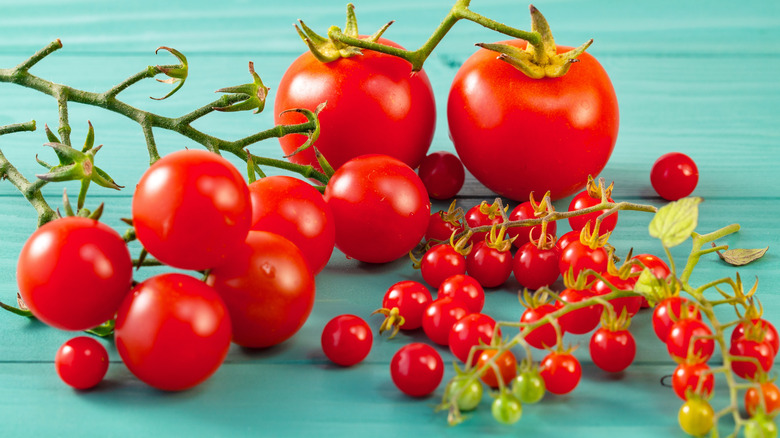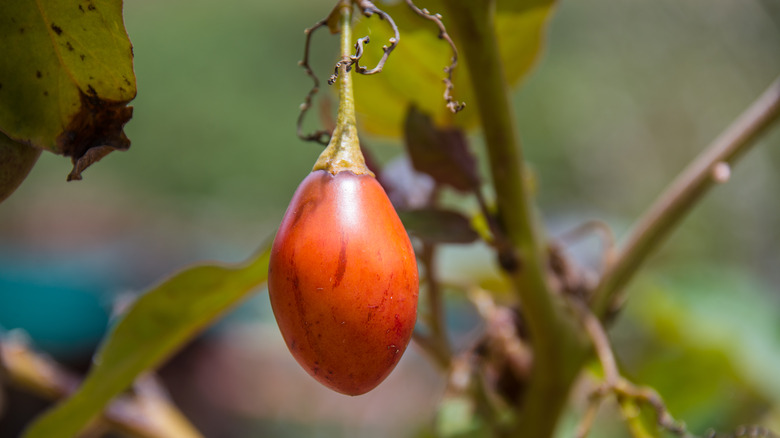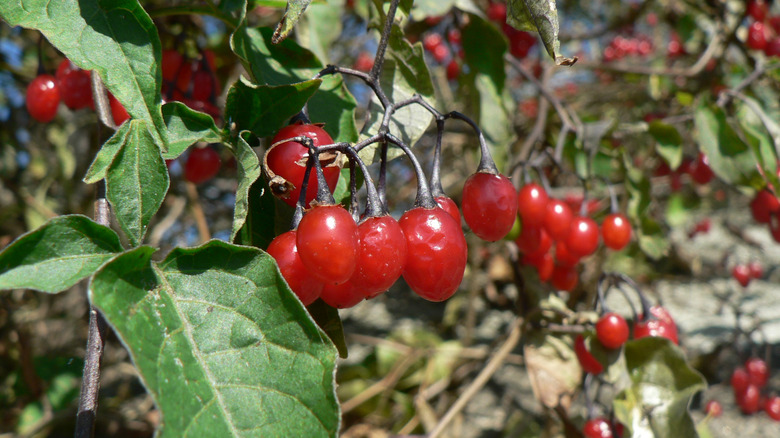Ancient Tomatoes Are Shaking Up Everything We Knew About The Fruit
Tomatoes are the bounty of summer. From the big, round, red, apple-shaped fruits we call vegetables to the bright yellow or even zebra-striped green heirloom tomatoes we find at bougie grocery stores and farmers' markets to the clusters of poppable round cherry tomatoes growing prolifically in the garden, the tomato is unmistakable. You'd recognize it anywhere, any day. Right?
Well, maybe not. What if we told you that the first wild tomatoes, the ones growing on mountainsides in Central and South America 80,000 years ago and still found wild today in the high elevations of Peru and Ecuador, looked more like little red currant berries? It's true. The ancestor of every tomato you've ever eaten in caprese salad, pizza sauce, salsa, and ketchup is an itty bitty berry called Solanum pimpinellifolium, known affectionately as "pimps."
And while today's farmers warily watch tomato blight maps and the wet, windy weather that carries the disease from field to field set to destroy this surprisingly delicate and needy crop (how many hours have been spent staking and stringing rows? Spraying against disease and pests? Carefully harvesting and packing?), hardy, scraggly pimp plants will grow seemingly anywhere and everywhere, with nothing stopping them. How did we get from these little clusters of flavor-packed, acidic and savory Peruvian berries to the tasteless red mealy burger topping and back again to juicy heirlooms on $22 sandwiches? Domestication in Southern Mexico, starting 7,000 years ago.
The very early history of the tomato
The long journey of the tomato from wild weed to your dinner plate starts in the middle Paleolithic era when these wild tomatoes were growing (potentially) unchecked. Historians are still unsure of when prehistoric humans settled the Americas — Neanderthals or other unknown extinct human species may have been here as long ago as 130,000 years ago, but current data has modern Homo sapiens venturing into the region 15,000 years ago. Somewhere between those two dates, around 80,000 years ago, the wild tomato evolved in Ecuador and Peru. The ancient people of this area don't seem to have done much domesticating, but somehow (currently unknown to science and history), the seeds made their way nearly 3,000 miles north to southern Mexico, where pre-Columbian farmers began domesticating and selectively breeding them 7,000 years ago. Over time and careful effort, this is where we got Solanum lycopersicum, today's tomato.
We also don't know exactly when the tomato made it from the Americas to Europe, but it was probably after Cortez came back, sometime after 1519. It would take more than two centuries for tomatoes to become staples in the European diet; early European tomato plants were from this domesticated Mexican strain and were exclusively ornamental for quite some time. This was, in part, because of their wide-ranging variety of shapes and colors, but also because Europeans were quite certain tomatoes were poisonous.
The Poison Myth
Scientifically, tomatoes belong to the Solanaceae family along with peppers, potatoes, and eggplants. Not all of its family members are edible, though — this family is also known as the nightshade family. If you aren't versed in popular medieval and Victorian poisons, the flowering, berry-bearing plants Solanum nigrum (black nightshade), Solanum dulcamara (bittersweet nightshade), and Atropa belladona (deadly nightshade) are highly toxic. Bittersweet nightshade, in particular, has clusters of red berries that look very similar to the wild "pimp" and early lycopersicum tomatoes. For centuries, Europeans were convinced that tomatoes were poisonous, mostly due to unfortunate trial and error.
Bittersweet nightshade is native to Eurasia, while the tomato was introduced from South America. The similar appearance of the plants certainly didn't go unnoticed, but moreover, Europeans were indeed accidentally poisoning themselves with tomatoes. First unsure of which part of the plant to eat, they attempted to eat the leaves. The leaves and stems of a tomato plant contain solanine; in large quantities, this glycoalkaloid poison can cause symptoms ranging from dilated pupils and GI distress to paralysis, hallucinations, and death. Once they figured out that the edible bits were the fruit of the plant, aristocrats took to eating them off of their prized pewter plates, full of lead. The acidity of the tomatoes would leech the lead into the fruit, and the diners would die of lead poisoning. Really, it's an unfortunate and unwarranted bad rap for the fruit, a grandchild of a fairly harmless wild berry.


